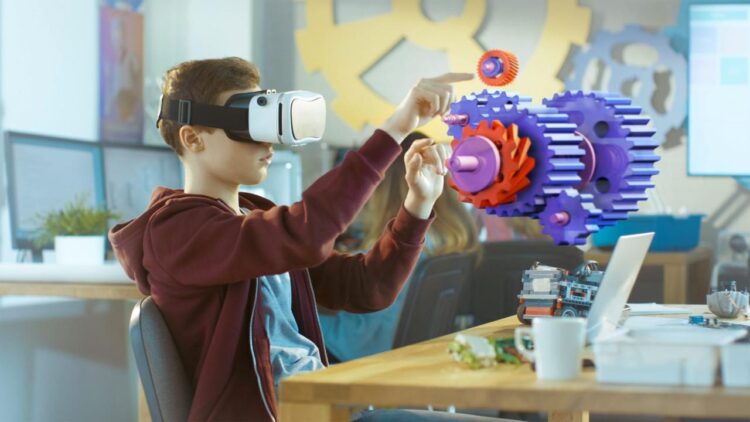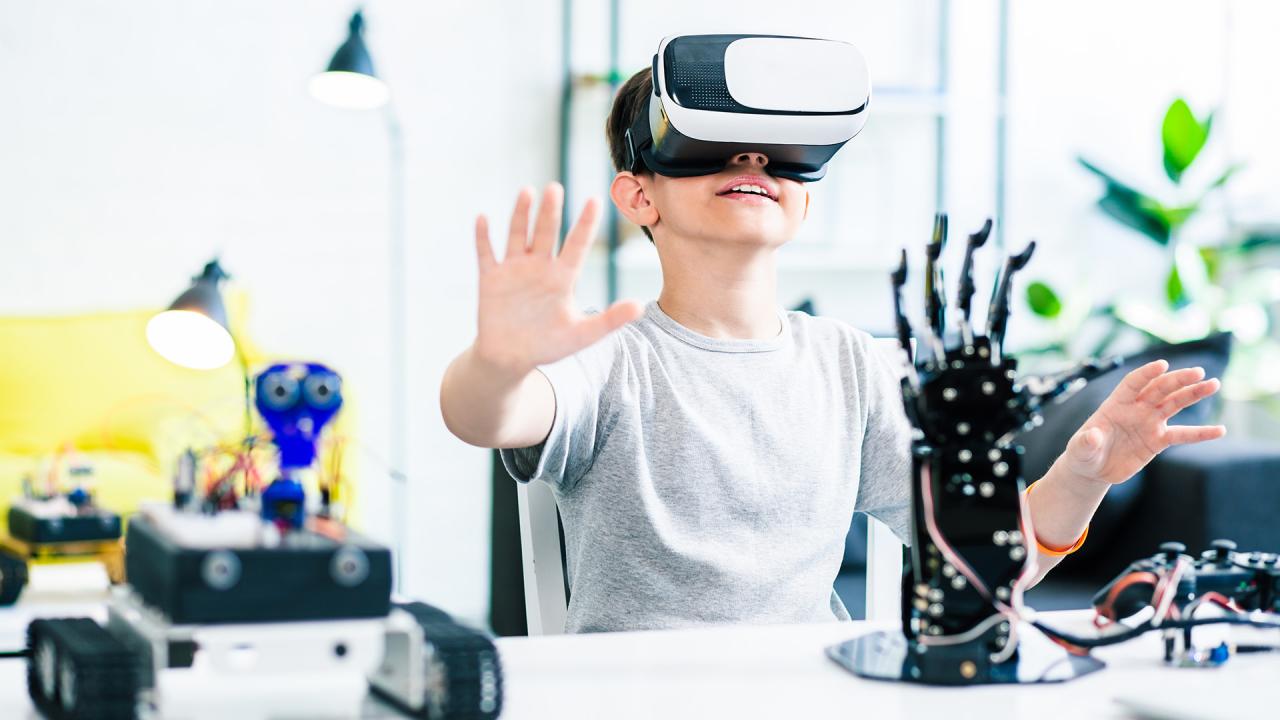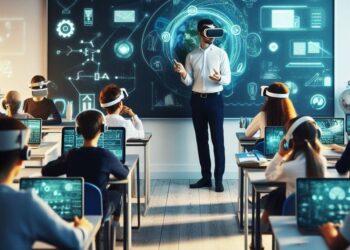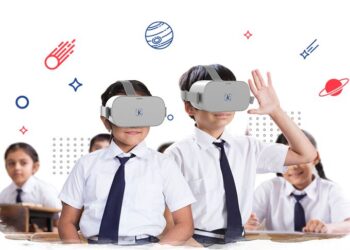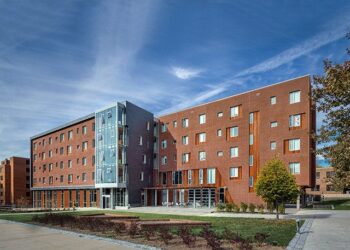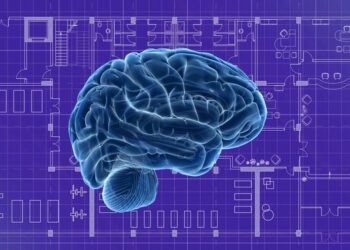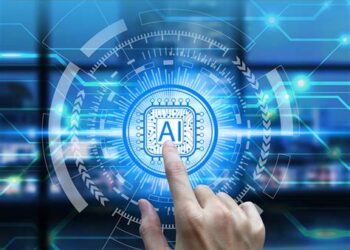What are VR and AR?
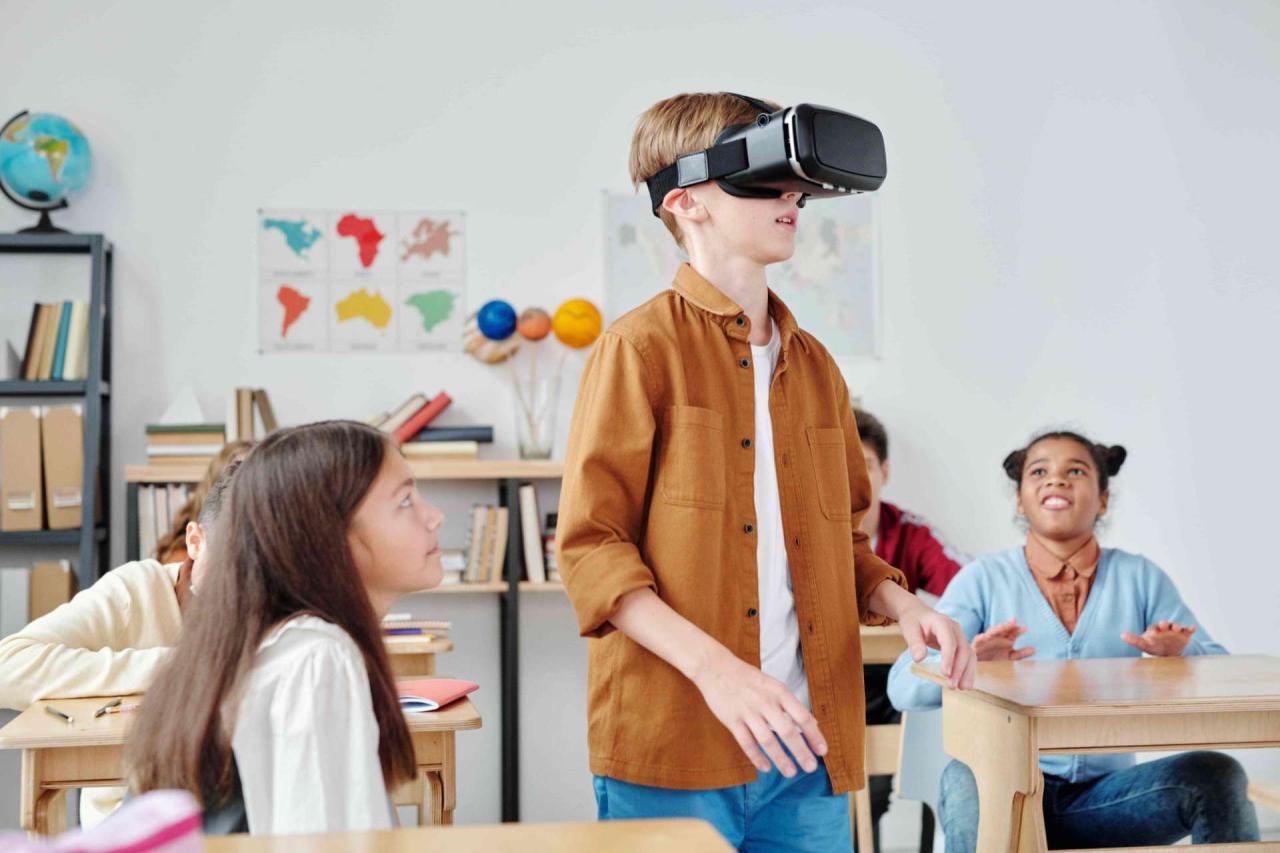
To fully appreciate their impact on education, it’s essential to differentiate between Virtual Reality and Augmented Reality:
A. Virtual Reality (VR): VR creates a completely simulated environment that can be experienced visually and aurally. Users typically wear a VR headset that blocks out the real world, immersing them in a digital space. This simulated world can be a realistic representation of a place (like a historical site or the human body) or a fantastical, imaginative realm. The core idea is complete immersion, allowing users to feel “present” within the virtual environment.
B. Augmented Reality (AR): AR overlays digital information onto the real world. Unlike VR, AR doesn’t replace the real environment; it enhances it. This is often experienced through smartphone or tablet cameras, or specialized AR glasses. For example, pointing your phone at a historical landmark and seeing digital information about it appear on your screen, or viewing a 3D model of a human heart floating above a textbook page. AR blends the digital with the physical, providing context-aware information.
Both technologies leverage advanced computer graphics, sensors, and tracking systems to create these immersive experiences, but their distinct approaches offer unique benefits for various learning scenarios.
The Evolution of Educational Technology
Education has always sought to leverage the latest tools to improve learning outcomes. From chalkboards to overhead projectors, and then to personal computers and the internet, each technological leap has brought new possibilities. The current surge in VR/AR in education is driven by several converging factors:
A. Increased Accessibility and Affordability: While initially expensive and niche, the cost of VR headsets and AR-compatible devices (like smartphones) has significantly decreased. This increased affordability makes these technologies more accessible to educational institutions and individual students.
B. Advancements in Hardware and Software: The processing power of devices has grown exponentially, enabling more realistic and interactive VR/AR experiences. Software development kits (SDKs) and content creation tools have also become more user-friendly, allowing educators and developers to create engaging educational applications more easily.
C. Demand for Experiential Learning: Modern pedagogy increasingly emphasizes active, experiential learning over passive information consumption. VR and AR perfectly align with this shift, offering unparalleled opportunities for hands-on, immersive experiences that are difficult or impossible to replicate in a traditional classroom setting.
D. The Digital Native Generation: Today’s students are digital natives, comfortable and adept with technology from a young age. Integrating VR/AR leverages their familiarity with digital interfaces and meets them where they are in terms of technological engagement.
E. The Need for Engaging Content: In an age of constant digital stimulation, traditional learning methods can struggle to capture and maintain student attention. VR/AR offers novel, highly engaging, and memorable ways to present educational content, combating disinterest and enhancing motivation.
How VR/AR Revolutionizes Study Methods:
The transformative power of VR and AR in education stems from their ability to create experiences that are otherwise impractical, dangerous, or impossible.
A. Immersive and Experiential Learning: This is arguably the most significant benefit. Instead of just reading about a concept, students can experience it directly. Imagine studying ancient Rome by virtually walking through the Colosseum, or learning about the human circulatory system by virtually traveling through arteries and veins. This deep immersion leads to a much richer understanding and longer retention of information compared to passive methods.
B. Enhanced Engagement and Motivation: The novelty and interactivity of VR/AR naturally capture student attention. Learning becomes an adventure, a game, or an exploration, rather than a chore. This increased engagement boosts motivation, encourages active participation, and fosters a genuine curiosity for the subject matter. When students are excited to learn, they are more likely to put in the effort required for mastery.
C. Improved Conceptual Understanding of Complex Topics: Abstract concepts often pose significant challenges in traditional learning. VR/AR can visualize these complexities in 3D, allowing students to manipulate models, observe processes from different angles, and interact with the elements. For example, understanding quantum mechanics, molecular structures, or the intricacies of an engine becomes far easier when students can virtually explore them.
D. Safe and Risk-Free Training Environments: For fields requiring practical skills, VR/AR offers invaluable opportunities for risk-free training. Medical students can practice complex surgeries without endangering patients, engineering students can assemble virtual machines without costly errors, and aspiring pilots can simulate flights without actual risk. This allows for repeated practice and mastery before real-world application.
E. Accessibility to Remote and Dangerous Environments: VR can transport students to places they could never physically visit – the surface of Mars, the inside of a volcano, or even historical events like the signing of the Declaration of Independence. This breaks down geographical and logistical barriers, democratizing access to unique learning experiences. Similarly, AR can bring dangerous experiments into the classroom virtually, without any safety risks.
F. Personalized and Adaptive Learning: VR/AR platforms can be designed to adapt to individual student paces and learning styles. They can track student progress, identify areas of difficulty, and provide customized feedback or alternative explanations. This personalized approach ensures that each student receives the support they need to succeed, moving away from a one-size-fits-all model.
G. Development of Spatial Reasoning and Motor Skills: Interacting with 3D environments in VR and manipulating virtual objects in AR significantly enhances spatial reasoning abilities. For subjects like architecture, design, or engineering, this is crucial. For training simulations, fine motor skills can also be developed through haptic feedback and precise virtual interactions.
H. Collaborative Learning Experiences: Many VR/AR platforms support multi-user environments, allowing students to learn and collaborate with peers in a shared virtual space, regardless of their physical location. They can work together on virtual dissections, solve engineering problems, or conduct scientific experiments as a team, fostering communication and teamwork skills.
I. Emotional Connection and Empathy: Immersive VR experiences can evoke strong emotional responses, which can be particularly powerful for subjects like history, social studies, or empathy training. Experiencing historical events or walking in someone else’s shoes can foster deeper understanding and empathy, making learning more impactful and memorable.
Diverse Applications of VR/AR Across Disciplines
The utility of VR and AR spans almost every academic discipline:
A. Science and Biology:
* VR: Virtual dissections of animals or human organs, exploring cellular structures, journeys through the solar system, simulating chemical reactions.
* AR: Overlaying anatomical models onto textbooks, interactive 3D periodic tables, visualizing molecular bonds on a lab bench.
B. History and Social Studies:
* VR: Immersive tours of ancient civilizations (Rome, Egypt), experiencing historical events (e.g., a trench in WWI), visiting world landmarks.
* AR: Bringing historical figures to life through interactive avatars, overlaying historical maps onto current landscapes, interactive timelines on classroom walls.
C. Engineering and Architecture:
* VR: Virtual walkthroughs of architectural designs before construction, simulating complex machinery operation, collaborative design reviews in a shared virtual space.
* AR: Projecting 3D blueprints onto construction sites, visualizing structural stress on physical models, interactive assembly guides for complex devices.
D. Medical and Healthcare Education:
* VR: Surgical training simulations, virtual patient interactions for diagnosis and treatment planning, exploring detailed human anatomy.
* AR: Overlaying patient data during surgery (e.g., veins on skin), guiding nurses for IV insertions, interactive 3D medical atlases.
E. Language Learning:
* VR: Immersive conversations with AI characters in a virtual foreign country, practicing real-life scenarios (e.g., ordering food, asking for directions).
* AR: Translating signs and menus in real-time, overlaying vocabulary words onto objects in the real environment.
F. Arts and Design:
* VR: Sculpting in 3D virtual space, painting immersive virtual landscapes, exploring art galleries from around the world.
* AR: Visualizing how furniture or artwork would look in a room before purchase, creating interactive digital art installations in physical spaces.
G. Vocational Training:
* VR: Simulating welding, operating heavy machinery, practicing emergency procedures for first responders.
* AR: Providing step-by-step repair instructions overlaid onto complex equipment, guiding technicians through maintenance tasks.
Challenges and Considerations for Widespread Adoption
Despite their immense potential, several hurdles need to be overcome for VR/AR to become truly ubiquitous in education:
A. Cost of Hardware: While prices are decreasing, equipping an entire school or university with high-end VR headsets and AR glasses can still be a significant investment, particularly for institutions in developing regions. Lower-cost, mobile-based VR solutions offer a more accessible entry point.
B. Content Development and Availability: Creating high-quality, educationally sound VR/AR content is complex, time-consuming, and expensive. A robust ecosystem of compelling and curriculum-aligned applications is essential for widespread adoption. There’s a need for more easy-to-use authoring tools for educators.
C. Technical Expertise and Support: Educators and IT staff need training to effectively integrate, manage, and troubleshoot VR/AR technologies. Technical support infrastructure must be in place to ensure smooth operation and address issues.
D. Curriculum Integration and Pedagogy: Simply having the technology isn’t enough; it must be meaningfully integrated into the curriculum. Educators need pedagogical training on how to best leverage VR/AR for learning objectives, moving beyond novelty to truly enhance educational outcomes.
E. Motion Sickness and User Comfort: Some individuals experience motion sickness or discomfort when using VR headsets, especially during extended sessions. Hardware and software developers are continuously working to mitigate this, but it remains a consideration for long-term use.
F. Equity and Access: Ensuring that all students, regardless of socioeconomic background, have equitable access to VR/AR technology is critical to prevent widening the digital divide. Strategies must be developed to provide access to underserved communities.
G. Data Privacy and Security: As with any digital technology, concerns about student data privacy and cybersecurity must be addressed. Robust protocols and policies are needed to protect sensitive information and ensure safe usage.
H. Maintenance and Upgrades: VR/AR hardware requires ongoing maintenance and periodic upgrades to keep pace with technological advancements. This adds to the long-term cost and management burden for educational institutions.
I. Teacher Training and Resistance to Change: Some educators might be resistant to adopting new technologies due to a lack of familiarity, perceived complexity, or skepticism about their educational value. Comprehensive professional development and clear demonstrations of effectiveness are key to overcoming this.
The Future of An Immersive and Interactive Frontier
The trajectory of VR and AR in education is undeniably upward. As these technologies mature, become more affordable, and content libraries expand, they are poised to fundamentally reshape the learning experience.
Imagine a future where:
- Every student has access to a personalized virtual lab, allowing them to conduct experiments, explore complex simulations, and make mistakes without consequence.
- History lessons involve time-traveling virtual field trips to ancient civilizations or pivotal moments, fostering a deep, empathetic connection to the past.
- Medical students perform intricate surgeries in highly realistic haptic VR environments, feeling the textures and resistances of virtual tissue.
- Architecture students virtually walk through their designs with clients in shared AR spaces, making real-time adjustments.
- Language learners converse with AI-powered avatars in virtual foreign cities, gaining fluency and cultural understanding in an authentic context.
VR and AR are not simply tools for passive consumption; they are powerful platforms for active creation, critical thinking, and collaborative problem-solving. By providing unparalleled immersion and interactivity, they can transform abstract concepts into tangible experiences, making learning more effective, engaging, and memorable. The shift from “reading about” to “doing within” is the core promise of VR/AR in education.
Conclusion
The integration of Virtual Reality and Augmented Reality into education marks a pivotal moment in the evolution of learning. While challenges remain, the clear benefits in terms of engagement, comprehension, and practical skill development are undeniable. As these technologies continue to advance and become more accessible, they will undoubtedly play an increasingly central role in preparing students for a future that demands dynamic, adaptable, and experientially rich learning. The immersive classroom of tomorrow is not a distant dream; it’s rapidly becoming a reality, thanks to the revolutionary power of VR and AR.

